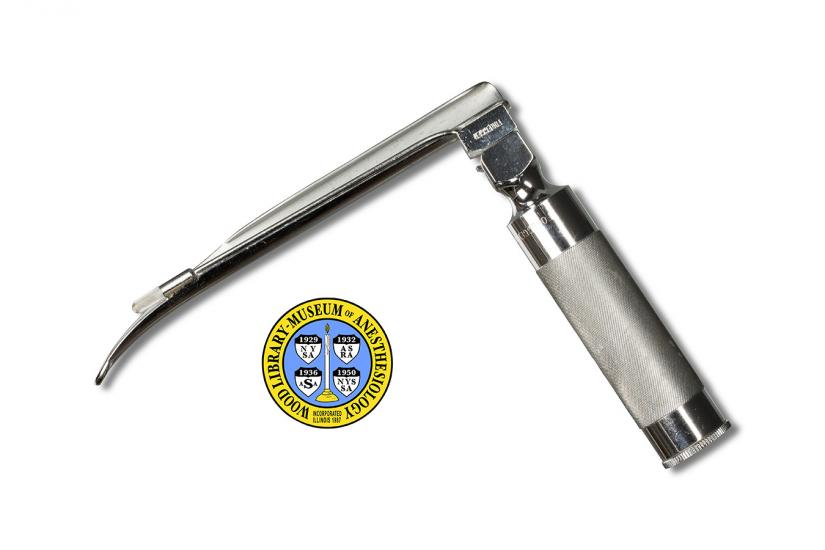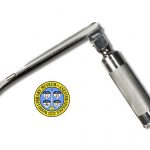Wisconsin Laryngoscope
The anatomy of the mouth and throat can vary significantly from person to person. For this reason laryngoscope blades come in a variety of shapes. The laryngoscope blade is the part of a laryngoscope that is inserted into a patient’s mouth so that the anesthesiologist can gently lift the tongue and other tissue just enough to see the opening to the lungs. A clear view allows the anesthesiologist to safely insert an endotracheal (breathing) tube and support respiration during anesthesia and surgery.
The laryngoscopy set pictured here includes a folding laryngoscope handle, three ‘Wisconsin’ blades, sizes 4, 3, and 2, and a size 1 ‘Miller’ blade. The Miller blade, the most popular straight blade, was introduced in 1941 by anesthesiologist Dr. Robert A. Miller (1906-1976). The Wisconsin blade, designed after a laryngoscope used by University of Wisconsin anesthesiologists at the Wisconsin General Hospital in Madison, is a straight blade with a very modest curve at the end of its slightly wide tip. It also has a relatively large semicircular cross-section. The intention of the design was to ease the creation of space for the endotracheal tube and thus facilitate its insertion.
The Foregger Company began to manufacture this style of blade around 1939. Eventually use of the Wisconsin blade for adults waned. However, the Wisconsin, a modification called the ‘Wis-Hipple,’ and the Miller blade continue to be primary options for the intubation of infants and small children.
Catalog Record: Wisconsin Laryngoscope
Access Key: akhp
Accession No.: 2012-11-30-1
Title: [Set of three Welch Allyn #670 laryngoscope blades, one Miller blade and one
laryngoscope handle.]
Corporate Author: Welch Allyn, Inc.
Corporate Author: Foregger Company.
Title: Wis-Foregger laryngoscope blades.
Title variation: Alt Title
Title: Set of three Wisconsin laryngoscope blades, one Miller blade and one
laryngoscope handle.
Title variation: Alt Title
Title: Wisconsin laryngoscope.
Publisher: [Skaneateles Falls, New York] : Welch Allyn, [1960-1972] ; [Roslyn Heights,
New York] : Foregger, [1960-1972].
Physical Descript: 1 laryngoscope set : brass, chrome, other metals, wood, textile, glass ; 7 x 21.5 17 cm.
Subject: Laryngoscopes.
Subject: Laryngoscopy.
Subject: Intubation, Intratracheal.
Note Type: General
Notes: Date range based on Foregger, Welch Allyn, and Ohio Medical Products catalogs
from 1937-1980s. Email communication with Welch Allyn representative, on July
1 and 2 of 2013, indicated that Welch Allyn did not make the ‘Wisconsin’
style of laryngoscope blade until the 1960s. The date range could change if
documentation indicates the range should be corrected.
Note Type: Citation
Notes: Catalog No. 7. New York: The Foregger Company; 1937: 58-60.
Note Type: Citation
Notes: Catalog No. 8. New York: The Foregger Company; 1942:89-90.
Note Type: Citation
Notes: Catalog No. 9. New York: Foregger; 1949:102-104.
Note Type: Citation
Notes: Catalog No. 11. New York: Foregger; 1952:120-121.
Note Type: Citation
Notes: Gillespie NA. Madison: University of Wisconsin Press; 1941:54,57,59.
Note Type: Citation
Notes: Gillespie NA. Madison: University of Wisconsin Press; 1963:59.
Note Type: Citation
Notes: King C, Rappaport LD. Emergent endotracheal intubation. In: King C, Henretig
FM, eds. Textbook of Pediatric Emergency Procedures. 2nd ed. Philadelphia:
Wolters Kluwer/Lippincott Williams & Wilkins; 2008:162.
Note Type: Citation
Notes: Laryngoscope reference information [sheet]. Skaneateles Falls, NY: Welch
Allyn, Inc.; [1986].
Note Type: Citation
Notes: Lavery GG, McCloskey BV. The difficult airway in adult critical care. Crit
Care Med. 2008;36(7):2163-2173.
Note Type: Citation
Notes: Lerman J, Sampathi V, Watt S. Induction, maintenance, and emergence from
anesthesia. In: Gregory GA, Andropoulos DB, eds. Gregory’s Pediatric
Anesthesia. 5th ed. Chichester, West Sussex: Wiley-Blackwell; 2012:338.
Note Type: Citation
Notes: The Metric Gas Machine [catalog of anesthesia related products]. New York:
Foregger Company; [1938]:46-48.
Note Type: Citation
Notes: Schapira M. A modified straight laryngoscope blade designed to facilitate
endotracheal intubation. Anesth Analg. 1973;54(4):553.
Note Type: Citation
Notes: The shape and sizes to meet your needs from Welch Allyn [advertisement].
Anesthesiology. 1968;29(2):19.
Note Type: Citation
Notes: Welch-Allyn Laryngoscopes [leaflet]. Skaneateles Falls, NY: Welch Allyn, Inc.
; 1962.
Note Type: Physical Description
Notes: A wooden flat box with two metal hinges in back and a metal latch in front;
The upper lid of the box is lined with light cushioning and a dark blue
textile; Within the box is a laryngoscope handle, four laryngoscope blades,
and three replacement lights; The handles and blades are of the folding kind;
The handle is made for D size batteries; Most of the outer surface of the
handle is tightly cross hatched for grip; Marked on the handle is the Welch
Allyn logo with the following text nearby, “SKAN. FALLS” and “N.Y. USA”;
“J37738” is marked at the battery opening of the handle; Three of the
laryngoscope blades are marked, “WELCH ALLYN #670”; All three Welch Allyn
laryngoscopes are marked with US patent number 2433705; The largest of the
Welch Allyn blades is marked with, “ADULT” and “4”; The next smaller size is
marked with, “CHILD” and “3”; The smallest of the three Welch Allyn blades is
marked, “INFANT” and “2”; The smallest laryngoscope blade in the case is held
in a felt pouch, marked with the following text, “TO AVOID LIGHT FAILURE USE
ONLY FOREGGER LAMP” and “FOREGGER, NEW YORK”; This smallest blade is marked
with the following text, “FOREGGER”, “MILLER 1”, and “PATENT PENDING”.
Note Type: Reproduction
Notes: Photographed by Mr. Steve Donisch on January 15, 2013.
Note Type: Historical
Notes: The anatomy of the mouth, throat and larynx can vary significantly from
person to person. For this reason laryngoscope blades come in a variety of
shapes, configurations, and sizes. Although the most popular laryngoscope
blade used for adult patients is a curved Macintosh blade, anesthesiologists
occasionally reach for a blade designed to address specific circumstances and
needs. The laryngoscope blade is the part of a laryngoscope that is inserted
into a patient’s mouth so that the anesthesiologist can gently lift the
tongue and other tissue just enough to see the larynx (opening to the trachea
that contains the vocal cords). A clear view of the larynx allows the
anesthesiologist to safely place an endotracheal (breathing) tube into the
trachea (windpipe) and support respiration during anesthesia and surgery.
The laryngoscopy set described here includes a folding laryngoscope handle,
three ‘Wisconsin’ blades, sizes 4, 3, and 2, and one size 1 ‘Miller’ blade.
The Miller blade is a straight blade that was introduced in 1941 by
anesthesiologist Dr. Robert Miller (1906-1976). It has a narrow tip and,
although it is a straight blade, a delicate curve that starts one to two
inches before the tip. The Wisconsin blade is a straight blade with a very
modest curve at the end of its slightly wide tip, and a relatively large
semicircular cross-section. The intention of the design was to ease the
creation of space for the endotracheal tube and thus facilitate its insertion
Eventually many anesthesiologists found that the greater height of this
blade increased the risk of damage to teeth in adult patients, and its use
waned. However, the Wisconsin, a modification called the Wis-Hipple, and the
Miller blade continue to be important options for the intubation of infants
and small children.
The “Wisconsin” laryngoscope blade was so named because its design was
inspired by a blade used by University of Wisconsin anesthesiologists at the
Wisconsin General Hospital in Madison. The Foregger Company began to
manufacture this style of blade around 1939, and mostly called it the
“Wis-Foregger” blade. The manufacturer of the blades described in this set,
Welch-Allyn, began making this style during the 1960s. Welch-Allyn first
identified the style by number, #670, and later, during the 1980s, by the
name “Wisconsin.”
Note Type: Exhibition
Notes: Chosen for the WLM website (noted June 10, 2013).


